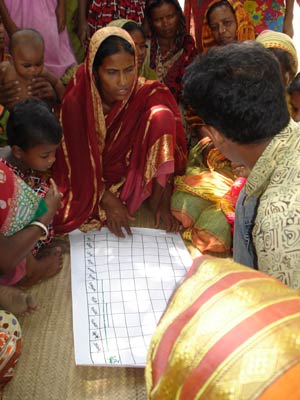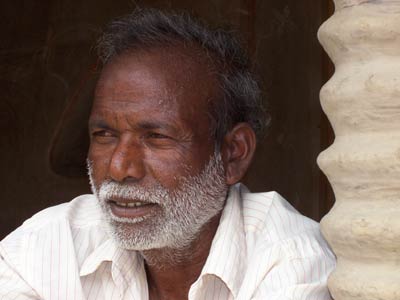 |
James S Pender argues that minorities warrant greater consideration in local, national and international responses to the climate threat. |
| The author is Development and Natural Resource Management Advisor with the Church of Bangladesh Social Development Programme. | |
Initially, action on climate change, in its focus on its global impacts, tended to overlook detail at a local level. Therefore, a working assumption that all communities and those within them would be impacted by climate change in somewhat similar ways was pursued; so it could be said that initial initiatives tended to be both gender-blind and age-blind. Encouragingly, in the last couple of years much has been written in terms of focusing on the specific needs of women and to a lesser extent on the specific needs of children, with more comprehensive approaches to meeting the particular needs of men, women and children being implemented in community adaptation projects.
Very little has, however, yet been written on the impacts of climate change on minorities, be they religious, ethnic, linguistic or caste, so perhaps the adaptation community could still be termed "colour-blind" in its approaches. This is despite the recognition in the Fourth Assessment Report of the Intergovernmental Panel on Climate Change that: "Impacts of climate change are likely to be felt most acutely not only by the poor, but also by certain segments of the population, such as the elderly, the very young, the powerless, indigenous peoples, and recent immigrants, particularly if they are linguistically isolated." Minority Rights Group International reports that, during flooding in the Slovakian community of Jarovnice in June 1998, following Hurricane Katrina in New Orleans in 2005, and in Bihar, India, in August 2007, minorities, namely Roma, African-Americans and Dalits, respectively, suffered disproportionately.
In terms of the impact of climate change, few places in the world will experience the range of effects and the severity of changes that will occur in Bangladesh. Potential changes include: average weather temperatures rising; more extreme hot and cold spells; rainfall being less when it is most needed for agriculture, yet more in the monsoon when it already causes floods; melting of glaciers in the source areas of Bangladesh's rivers altering the hydrological cycle; more powerful tornados and cyclones; and sea-level rise displacing communities, turning freshwater saline and facilitating more powerful storm surges.
Bangladesh is relatively racially and religiously homogenous, with around 85 per cent of its population being both Muslim and ethnically Bengali. Religious minorities include 12 per cent Hindus, many of whom are Dalits and considered "untouchables" (even by non-Hindus), with the remaining three per cent including Christians, Buddhists, and Animists (following traditional nature-worshipping religions). Many members of these minority religious groups are also members of minority ethnic groups making them "double" minorities. In addition, there are at least 27 ethnic groups making up around one per cent of the population and up to 47 language groups in Bangladesh. So while the percentage of minority populations is rather low, the number of minority groups and sub-groups is very large, while ethnic minorities alone number over a million people.
 |
|
Discussing climate change at a Pahari village
© James S Pender |
Perhaps because Bangladesh's minority communities are so fragmented, it makes them particularly vulnerable to discrimination and negative socio-religious prejudice, for in very few places are they in a majority and they are widely misunderstood by the Muslim Bengali community. Being minorities that are often despised by many in the majority community, these smaller communities are already considerably disadvantaged by many social development criteria. For example, only half of language minority children are enrolled in school with around 60 per cent of those dropping-out later. Eighty-five per cent of indigenous ethnic minorities in north-west Bangladesh are landless and 100,000 indigenous people from the Chittagong hill tribes were forced off their land to make way for settlers from the majority community.
World Bank Group President Robert B Zoellick put it well, while opening a roundtable discussion on Indigenous Peoples and Climate Change in the United States in November 2009, when he said that indigenous peoples carry a "disproportionate share of the burden of climate change effects, as climate change exacerbates the difficulties that indigenous communities already face - including loss of land and resources, lower human development indicators, discrimination, unemployment, and economic and political marginalization."
In Bangladesh, a large proportion of indigenous people are economically vulnerable, working as day-labourers, subsistence farmers or hunter-gatherers, living in poor quality housing with few assets. The majority of these ethnic minorities are additionally located in areas highly vulnerable to the effects of climate change: Rajshahi Division in the north-west vulnerable to drought; Sylhet in the north-east and the Chittagong Hill Tracts vulnerable to flash flooding; and on the southern and south-western coasts vulnerable to cyclones, storm surges and coastal erosion.
 |
|
Santal man
© James S Pender |
Sea-level rise and loss of coastal land, both physically and due to salinization, raises further threats. Will it lead to those displaced from the majority community in turn forcing minorities off their lands? This may especially be the case in an area perceived to be empty area such as the Chittagong Hill Tracts (although cultivable land there is limited). Resettlement will be even more of a challenge for the large numbers of Hindus and Buddhists that reside in the coastal zone due to prejudices.
What can be done?
First, there is a need to consider the needs of minorities and desegregate data where necessary to ensure their involvement in adaptation projects. Their needs may be different in many areas due to varying cultural practices, natural resource usage and remote locations. For example, in the Barind Tract, indigenous communities such as Santals and Paharis were formerly much more reliant on wild animals, plants and birds for food than the agriculturalist Bengalis. Due to a more arid environment, as well as the loss of common land to settler farmers, these food sources have dramatically reduced with a huge impact on nutrition for these minorities. The identification and cultivation of "wild" plants, formerly harvested from fallow/common land, in household kitchen gardens is one such approach that the Church of Bangladesh Social Development Programme, with the support of the Department of Botany of Rajshahi University, is developing.
Second, disaster management plans also need to consider the needs of minorities and either build inter-community harmony or make separate provision. For example, in the Sundarbans, members of the Munda community were not welcome in cyclone shelters as they are considered "untouchable" by the majority community. They were ignored by mainstream relief efforts following Cyclone Sidr due to their small and remote villages in the forest.
Third, minorities need adequate representation in both national and international processes that are planning adaptation and mitigation initiatives, such as in country-level plans like National Adaptation Programmes of Action or in the climate treaty negotiations where until now they have been largely sidelined. It is essential that minorities should be assisted in becoming part of local, regional and national planning on adaptation or mitigation. If they cannot participate in the decisions that will affect the outcomes of global warming, then the chances are that their needs will be ignored.
Fourth, on a positive note, to quote Robert B Zoellick again, "indigenous communities, with their long experience in managing natural resources, and adapting to natural changes in the climate can also add to our knowledge and understanding of how best to cope with the complex challenge of human caused climate change. Learning from Indigenous Peoples will make our discussions richer and our actions more productive in respect to climate change adaptation and mitigation."
Further information
James S Pender, Christian Mission Hospital, Kazihata, Rajshahi 6000, GPO Box #25, Rajshahi District, Bangladesh. Email: penderjs@gmail.com.
On the Web
The report Climate Change, its Impacts and Possible Community Based Responses in Bangladesh by the author is available online. The Tiempo Climate Cyberlibrary lists selected websites covering climate change and Bangladesh and indigenous peoples.